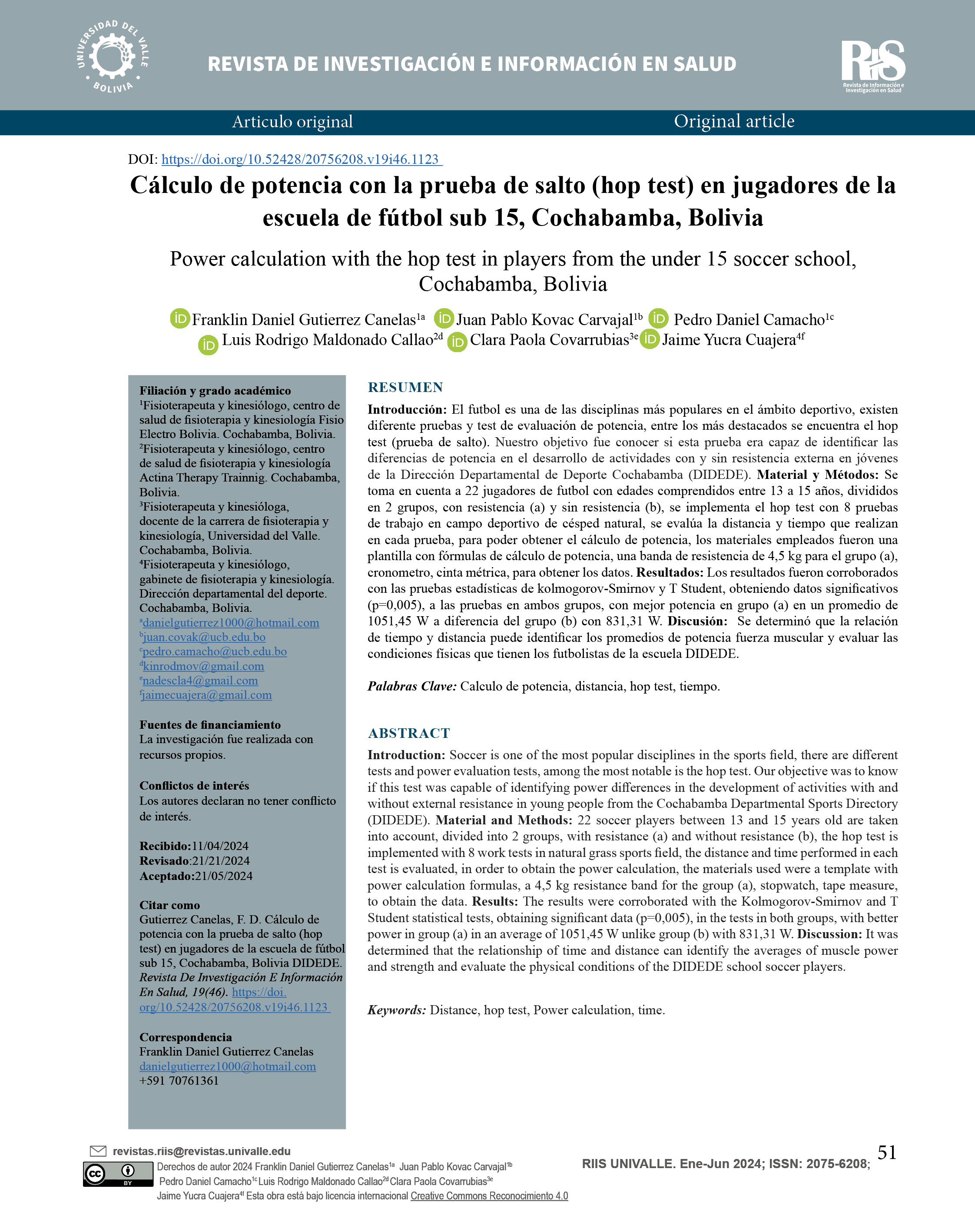Power calculation with the hop test in players of the U15 Didede soccer school
DOI:
https://doi.org/10.52428/20756208.v19i46.1123Keywords:
Hop Test , Tiempo y distancia, Calculo de PotenciaAbstract
Introduction: Soccer is one of the most popular disciplines in the sports field, there are different tests and power evaluation tests, among the most prominent is the Hop Test. Our objective was to know if this test was capable of identifying the power differences in the development of activities with and without external resistance in youngsters under fifteen from the DIDEDE soccer school.
Material and Methods: 22 soccer players aged between 13 and 15 years are taken into account, divided into 2 groups, with resistance (a) and without resistance (b), the Hop Test is implemented with 8 work tests in natural grass sports field, the distance and time performed in each test is evaluated, in order to obtain the power calculation, the materials used were a template with power calculation formulas, a 4.5 kg resistance band for the group a, stopwatch, tape measure, to obtain the data.
Results: The results were corroborated with the Kolmogorov-Smirnov and T Student statistical tests, obtaining significant data (p=0.005), for the tests in both groups, with the best power in group (a) at an average of 1051.45 W. unlike group (b) with 831.31 W.
Conclusions: It was determined that the relationship of time and distance can identify the average muscular strength power and evaluate the physical conditions of the soccer players of the DIDEDE school.
Downloads
References
Sebreli JJ. La era del futbol. Buenos Aires:; 2011.
Yuri Hermanadez Preto G. Efectos de un entrenamiento específico de potencia aplicado a futbolistas juveniles para la mejora de la velocidad con cambio de dirección. European Journal of Human Movement. 2013;: p. 17-36.
Troule S, Casamichanana D. Aplicación de pruebas funcionales para la detección de asimetrías en jugadores de fútbol. Journal of Sport and Health Research. 2016;: p. 1-12.
Kelley Fitzgerald SLJH. Hop Tests as Predictors of Dynamic Knee Stability. Journal of Orthopaedic & Sports Physical Therapy. 2001;: p. 588/597.
https://doi.org/10.2519/jospt.2001.31.10.588 DOI: https://doi.org/10.2519/jospt.2001.31.10.588
PMid:11665746
Guerrero Cangui JC. Proyecto para la implementación de un centro de formación profecional de futbol en el sector sur de Quito. Universidad politecnica salesiana Ecuador. 2011;: p. 22-37.
Esneider Patiño B, Wheeler , Botero CA. Validación y fiabilidad del sensor Wheeler Jump para la ejecución del salto con contramovimiento. apunts, educacion fisica y deporte. 2022;: p. 1-8.
Kelley F, Scott L, Ji Hy H, Maj Robert S W. Hop Tests as Predictors of Dynamic Knee Stability. Journal of Orthopaedic & Sports Physical Therapy. 2001;: p. 1-10.
Oyarzo C, Said M, Nazar M. Correlación del Single Hop Test con la prueba de Velocidad en treinta metros en infantes. RETOS. Nuevas Tendencias en Educación Física, Deporte y Recreación. 2017;: p. 1-6.
Lara A, Abian J, Alegre Duran L, Jimenez L, Aguado X. Medicion directa de la potencia con test de salto. Universidad de Castilla-La Mancha. 2005;: p. 2-10.
Mensi Malerba LA. Pruebas de salto. Argentinian Journal of respiratory and phisical therapy. 2020;: p. 52-55.
https://doi.org/10.58172/ajrpt.v2i2.111 DOI: https://doi.org/10.58172/ajrpt.v2i2.111
Paus V, Ariel G. Alta médico deportiva en reconstrucciones del ligamento cruzado anterior. Asociación Argentina de traumatologia y del deporte. 2020;: p. 3-11.

Published
How to Cite
Issue
Section
License
Copyright (c) 2024 Franklin Daniel Gutierrez Canelas

This work is licensed under a Creative Commons Attribution 4.0 International License.
Authors who publish with this journal agree to the following terms:
- Authors retain copyright and grant the journal right of first publication with the work simultaneously licensed under a Creative Commons Attribution License 4.0 that allows others to share the work with an acknowledgement of the work's authorship and initial publication in this journal.
- Authors are able to enter into separate, additional contractual arrangements for the non-exclusive distribution of the journal's published version of the work (e.g., post it to an institutional repository or publish it in a book), with an acknowledgement of its initial publication in this journal.
- Authors are permitted and encouraged to post their work online (e.g., in institutional repositories or on their website) prior to and during the submission process, as it can lead to productive exchanges, as well as earlier and greater citation of published work.






















